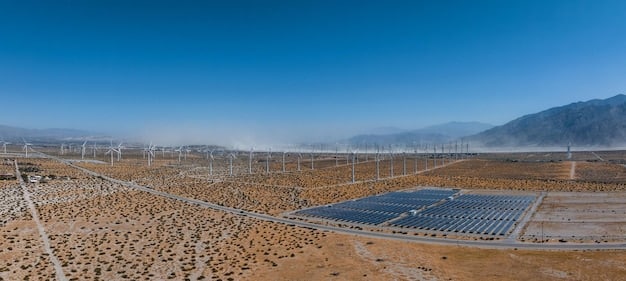Infrastructure Bill: How $50 Billion Boosts US Renewable Energy

The Infrastructure Investment and Jobs Act allocates $50 billion to renewable energy projects, aiming to modernize the US energy sector, enhance grid reliability, expand renewable energy sources, and create jobs through investments in clean energy technologies.
The new Infrastructure Bill’s $50 billion allocation for renewable energy projects is poised to reshape the US energy sector, aiming to modernize infrastructure and accelerate the transition to cleaner energy sources. Let’s explore how this investment could play out.
The Infrastructure Bill: A Catalyst for Renewable Energy
The Infrastructure Investment and Jobs Act signifies a pivotal moment for the US energy sector. With a substantial $50 billion earmarked for renewable energy projects, the bill seeks to modernize the nation’s energy infrastructure, enhance grid reliability, and expedite the adoption of clean energy technologies.
Modernizing Energy Infrastructure
A significant portion of the allocated funds will be directed toward upgrading existing energy infrastructure. This includes modernizing the power grid to accommodate increased renewable energy sources, such as solar and wind power. Enhanced grid infrastructure is essential for transmitting renewable energy efficiently and reliably from remote generation sites to urban centers.
Enhancing Grid Reliability
Grid reliability is another critical area targeted by the infrastructure bill. Investments will be made in technologies that improve grid resilience, such as smart grid systems and energy storage solutions. These enhancements are designed to minimize disruptions and ensure a stable energy supply, even in the face of extreme weather events.

Here are some key areas of investment for modernizing energy infrastructure:
- Smart Grid Technologies: Implementation of advanced monitoring and control systems to optimize energy distribution.
- Energy Storage: Development of battery storage and pumped hydro facilities to store excess renewable energy for later use.
- Transmission Lines: Upgrading and expanding transmission infrastructure to connect renewable energy sources to consumers.
The Infrastructure Bill’s focus on modernizing the energy infrastructure and enhancing grid reliability is expected to lay the foundation for a more resilient and sustainable energy future in the US. By improving the efficiency and stability of the grid, the bill aims to support the widespread adoption of renewable energy sources.
Expanding Renewable Energy Sources
A primary goal of the infrastructure bill is to accelerate the expansion of renewable energy sources across the United States. The $50 billion allocation is intended to incentivize the development and deployment of solar, wind, hydropower, and other clean energy technologies. This initiative is expected to drive significant growth in the renewable energy sector, contributing to a cleaner and more sustainable energy mix.
Solar Energy Initiatives
Solar energy is poised to benefit significantly from the infrastructure bill. Funds will be allocated to support the installation of solar panels on residential, commercial, and industrial buildings, as well as the development of large-scale solar farms. Tax incentives and grants will further encourage the adoption of solar energy by individuals and businesses.
Wind Energy Development
Wind energy is another key area of focus for the infrastructure bill. Investments will be made in the construction of new wind farms, both onshore and offshore, to harness the abundant wind resources available across the US. The bill also aims to streamline the permitting process for wind energy projects, reducing regulatory hurdles and accelerating development timelines.
Key initiatives for expanding renewable energy sources include:
- Tax Credits: Providing tax incentives for renewable energy projects to reduce the upfront costs of development and deployment.
- Grants: Offering grants to support research, development, and deployment of innovative renewable energy technologies.
- Loan Programs: Establishing loan programs to provide low-cost financing for renewable energy projects.
By expanding renewable energy sources, the infrastructure bill aims to reduce the nation’s reliance on fossil fuels and mitigate the impacts of climate change. The increased deployment of solar, wind, and other renewable energy technologies is expected to create jobs, stimulate economic growth, and improve air quality across the United States.
Job Creation in the Clean Energy Sector
The infrastructure bill’s $50 billion allocation for renewable energy projects is projected to create numerous jobs in the clean energy sector. These jobs will span a wide range of occupations, from manufacturing and construction to engineering and project management. The bill aims to support workforce development and training programs to ensure that workers have the skills needed to succeed in the growing clean energy industry.
Manufacturing Jobs
The manufacturing sector is expected to see significant job growth as a result of the infrastructure bill. Increased demand for solar panels, wind turbines, and other renewable energy equipment will drive investment in domestic manufacturing facilities. This will create jobs for factory workers, technicians, and engineers.
Construction and Installation Jobs
Construction and installation jobs will also be in high demand as renewable energy projects are developed and deployed across the country. These jobs will involve the construction of solar farms, wind farms, and other renewable energy facilities, as well as the installation of solar panels on buildings and the upgrading of transmission infrastructure.

Here’s a breakdown of job creation opportunities:
- Solar Panel Installers: Installing and maintaining solar panels on residential and commercial buildings.
- Wind Turbine Technicians: Inspecting, maintaining, and repairing wind turbines.
- Electrical Engineers: Designing and overseeing the construction of renewable energy projects.
The infrastructure bill’s emphasis on job creation in the clean energy sector is expected to provide economic opportunities for workers across the United States. By investing in workforce development and training programs, the bill aims to ensure that workers have the skills needed to transition to clean energy jobs and contribute to the growth of the renewable energy industry.
Regulatory and Policy Changes
The impact of the infrastructure bill on the US energy sector will be shaped by regulatory and policy changes that facilitate the development and deployment of renewable energy projects. Streamlining the permitting process, establishing clear regulatory guidelines, and providing financial incentives are key steps in accelerating the transition to clean energy.
Permitting Process Streamlining
One of the main challenges facing renewable energy developers is the lengthy and complex permitting process. The infrastructure bill seeks to address this issue by streamlining the permitting process for renewable energy projects, reducing regulatory hurdles and accelerating development timelines. This will involve coordinating permitting reviews across federal, state, and local agencies to ensure timely and efficient decision-making.
Regulatory Certainty
Regulatory certainty is essential for attracting investment in renewable energy projects. The infrastructure bill aims to provide clarity and predictability in regulatory requirements, ensuring that developers have a clear understanding of the rules governing the development and operation of renewable energy facilities. This will help reduce uncertainty and encourage private sector investment in renewable energy.
Key regulatory and policy changes include:
- Renewable Portfolio Standards: Establishing targets for the percentage of electricity that must come from renewable sources.
- Tax Incentives: Expanding tax credits and deductions for renewable energy projects.
- Land Use Policies: Promoting land use policies that support the development of renewable energy facilities.
By implementing these regulatory and policy changes, the infrastructure bill aims to create a more favorable environment for renewable energy development, attracting private sector investment and accelerating the transition to a cleaner and more sustainable energy system.
Environmental Impact and Sustainability
The infrastructure bill’s investments in renewable energy projects are expected to have a positive impact on the environment and promote sustainability. By reducing reliance on fossil fuels, the bill aims to lower greenhouse gas emissions, improve air quality, and protect natural resources. The transition to clean energy sources is a key strategy in mitigating the impacts of climate change and creating a more sustainable future.
Reducing Greenhouse Gas Emissions
One of the primary environmental benefits of the infrastructure bill is the reduction of greenhouse gas emissions. Renewable energy sources such as solar, wind, and hydropower produce electricity without emitting carbon dioxide or other pollutants that contribute to climate change. By increasing the share of renewable energy in the nation’s energy mix, the bill aims to significantly reduce the carbon footprint of the US energy sector.
Improving Air Quality
The transition to renewable energy sources is also expected to improve air quality across the United States. Fossil fuel power plants emit pollutants such as sulfur dioxide, nitrogen oxides, and particulate matter that can cause respiratory problems and other health issues. By replacing fossil fuel power plants with clean energy facilities, the infrastructure bill aims to reduce air pollution and improve public health.
Here are some ways the bill promotes environmental sustainability:
- Clean Energy: Transitioning to sources that do not emit greenhouse gases or air pollutants.
- Resource Conservation: Promoting the efficient use of natural resources, such as water and land.
- Ecosystem Protection: Minimizing the environmental impacts of energy development.
By promoting clean energy, resource conservation, and ecosystem protection, the infrastructure bill aims to create a more sustainable energy system that benefits both the environment and society. The investments in renewable energy projects are a critical step in addressing climate change and creating a healthier planet for future generations.
Economic Growth and Innovation
The infrastructure bill’s $50 billion allocation for renewable energy projects is expected to spur economic growth and innovation across the United States. Investments in clean energy technologies will drive innovation in areas such as energy storage, smart grid systems, and advanced materials. This will create new business opportunities, attract private sector investment, and strengthen the nation’s competitiveness in the global clean energy market.
Innovation in Energy Storage
Energy storage is a critical component of a renewable energy system. The infrastructure bill aims to support innovation in energy storage technologies such as batteries, pumped hydro, and compressed air storage. These technologies allow renewable energy to be stored for later use, improving the reliability and flexibility of the grid. Breakthroughs in energy storage are expected to reduce costs, increase efficiency, and unlock new applications for renewable energy.
Smart Grid Systems
Smart grid systems use advanced sensors, communication networks, and data analytics to optimize energy distribution and improve grid reliability. The infrastructure bill aims to support the development and deployment of smart grid technologies, enabling real-time monitoring and control of energy flows. This will allow grid operators to manage renewable energy resources more efficiently, reduce transmission losses, and improve the resilience of the grid.
Examples of economic growth and innovation include:
- Venture Capital: Attracting venture capital investment in clean energy startups.
- Research and Development: Funding research and development of innovative energy technologies.
- Public-Private Partnerships: Encouraging collaboration between government, industry, and academia.
By fostering innovation and attracting private sector investment, the infrastructure bill aims to create a vibrant and competitive clean energy industry that drives economic growth and creates jobs across the United States. The investments in renewable energy projects are a key step in building a more prosperous and sustainable future.
| Key Point | Brief Description |
|---|---|
| ⚡ Grid Modernization | Upgrading infrastructure for better renewable energy integration. |
| ☀️ Solar Expansion | Incentivizing solar panel installation for homes and businesses. |
| 🏭 Job Creation | New jobs in manufacturing, construction, and engineering sectors. |
| 🌎 Environmental Benefits | Lowering emissions and improving air quality through clean energy. |
Frequently Asked Questions (FAQ)
▼
The primary goal is to modernize the US energy sector by investing in renewable energy infrastructure, enhancing grid reliability, and accelerating the adoption of clean energy technologies.
▼
The bill will invest in smart grid technologies and energy storage solutions to minimize disruptions and ensure a stable energy supply, even during extreme weather events.
▼
Solar and wind energy are major beneficiaries. The bill supports the installation of solar panels and the construction of new wind farms, both onshore and offshore.
▼
Jobs will be created in manufacturing, construction, engineering, and project management, spanning the entire clean energy sector supply chain.
▼
By reducing reliance on fossil fuels, the bill lowers greenhouse gas emissions, improves air quality, and protects natural resources, promoting a more sustainable energy system.
Conclusion
In conclusion, the Infrastructure Investment and Jobs Act’s $50 billion allocation for renewable energy projects is set to transform the US energy sector. By modernizing infrastructure, expanding renewable energy sources, creating jobs, and promoting environmental sustainability, the bill paves the way for a cleaner, more resilient, and economically robust energy future.





